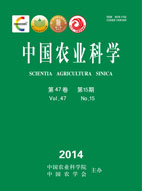-
Effects of Integrated Agronomic Practices on Leaf Senescence Physiological Characteristics of Summer Maize
- ZHU Kun-Lun, JIN Li-Bin, DONG Shu-Ting, ZHAO Bin, LIU Peng, ZHANG Ji-Wang
-
Scientia Agricultura Sinica. 2014, 47(15):
2949-2959.
doi:10.3864/j.issn.0578-1752.2014.15.005
-
 Abstract
(
577 )
Abstract
(
577 )
 HTML
(
3 )
HTML
(
3 )
 PDF (678KB)
(
815
)
PDF (678KB)
(
815
)
 Save
Save
-
References |
Related Articles |
Metrics
【Objective】This study is to explore the effects of integrated agronomic practices on leaf senescence physiological characters of summer maize. 【Method】 Zhengdan958 was used as experimental material, integrated agronomic managements experiment (MT), including 4 treatments of T1, T2, T3 and T4, and nitrogen rate experiment (0, 129.0, 184.5, 300.0 kg N hm-2, signed by N0, N1, N2, N3) which was based on T4 treatment were designed to explore the effects of integrated agronomic practices and nitrogen rate on leaf area index (LAI), photosynthetic pigments content, superoxide dismutase (SOD), catalase (CAT) and peroxidase (POD) activities and malondialdehyde (MDA) content in ear leaves of summer maize through the optimal combinations of planting methods, sowing and harvest date, as well as nitrogen fertilizer application timing and rate. 【Result】 LAI of T4 was always above 4.4 from V12 to 42 days after tasseling (VT), which was significantly higher than those of T1 and T2, and the LAI reduction of T4 was slower in later growing period. As for nitrogen rate treatments (NT), the LAI was increased with the increasing of nitrogen rate. The LAI of N3 decreased by 14.9% from 28 days after VT to R6 which was higher than those of the other treatments. As for MT and NT, the photosynthetic pigments content got the maximum value on 14 day after VT and then decreased, following the change of unimodal curve. From 14 days after VT to 42 days after VT, the chlorophyll (a+b) content of T1, T2, T3, T4 decreased by 21.1%, 22.0%, 27.2% and 18.4% and the carotenoid content of T1, T2, T3, T4 decreased by 26.6%, 26.9%, 32.2% and 25.0%, respectively. On 42 day after VT, the content of chlorophyll a, chlorophyll b, chlorophyll (a+b) and carotenoid in T4 were increased by 6.0%, 13.0%, 6.9%, 9.3% compared to T1, respectively. As for NT, the content of chlorophyll a, chlorophyll b and chlorophyll (a+b) increased significantly with the increasing of nitrogen rate. The carotenoid content of N3 decreased rapidly in latter growing period, and which was decreased by 4.5% compared to that of N0 on 42 day after VT. In MT and NT, the activities of SOD, CAT and POD got the maximum value on 14 day after VT and then decreased, following the change of unimodal curve. The SOD, CAT and POD activities of T4 always remained at high levels and its decreasing was lower in the latter growing period. In NT, SOD, CAT and POD activities were increased as the increasing of nitrogen rate, the protective enzymes activity of N3 decreased faster than those of the other treatments. In MT and NT, MDA content increased following the growth process, and decreased with the increasing of nitrogen rate. MDA content of T4 always remained at low levels. 【Conclusion】 When the nitrogen rate was higher than 184.5 kg•hm-2, photosynthetic pigments content and protective enzymes activity of leaves couldn’t be increased and MDA content couldn’t be decreased continuously with the increasing of nitrogen rate, which was not helpful to increase nitrogen use efficiency. By increasing plant density, changing relay intercropping to direct seeding, and delaying sowing and harvesting date, as well as optimizing nitrogen fertilizer application timing and rate, photosynthetic pigment content of ear leaves in T4 decreased slower, protective enzymes activity were higher, and MDA content was lower, which was helpful to improve both grain yield and nitrogen use efficiency together.









